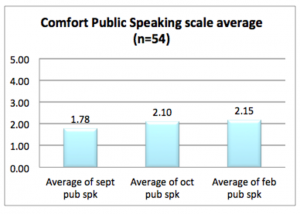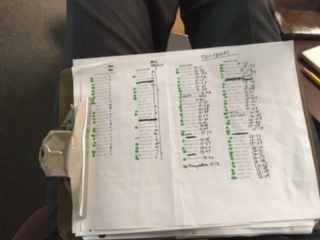Last school year, I studied the impact of a fairly simple method for increasing public speaking comfort in kids. Thanks to support from Character Lab, I was able to verify that, indeed, this intervention produced a statistically significant improvement in public speaking comfort. (See Figure 1.) The activity is meant to take place during the first six weeks of school, but could probably be implemented with success in any classroom where teachers are concerned that students are struggling with anxiety around public speaking.

Phase 1: Think-Pair-Share with every student participating in Share mode at least once per week

If I'm on my game, I use Think-Pair-Share at least once per class period. Like me, Think-Pair-Share is a product of the 80s; unlike me, Think-Pair-Share is perfect. Kids can learn it in a week, learn my expectations for it in the same amount of time, and it provides nervous kids the perfect entryway into whole-class speaking. During Share mode, I try to balance calling on volunteers or using my set of index cards to call on kids randomly. Using my trusty clipboard (see Figure 2), I track which students speak during Share mode, and I ensure that, each week, every kid Shares at least once. (In research-speak, the once-per-week Share is the manipulation check.)
Summary: 3 weeks of Think-Pair-Share, every kid Sharing at least 1x/week, 3x total
Phase 2: Pop-Up Debates with every student speaking at least once per debate
After Phase 1, every child has spoken for the whole class to hear at least three times, and this has taught the nervous ones a critical lesson: when I speak to the class, I come out okay on the other side. They are now ready for a successful first pop-up debate… and then a successful second and third one.
With each of these debates, my primary goal is getting kids comfortable with the format and getting them used to pushing themselves personally with a public speaking, argumentative, or PVLEGS delivery goal. I want them all to see that these whole class discussions and debates are about argumentative, collaborative speaking that gets to the bottom of a question.
Again, I keep track of their participation on my clipboard, and I sometimes award a classwork grade for successful demonstration of the day's target skill.
Summary: 3 Pop-Up Debates, as quickly as 1x/week, with every kid speaking at least 1x/debate
Once Phases 1 and 2 are complete, students have spoken for the whole class to hear at least 6 times, and they are now likely to keep participating in whole-class speaking situations for the rest of the year. This two-phase sequence isn't a silver bullet, but it's time-tested and has some evidence to support its validity.
Lynsay Mills Fabio says
Hi Dave! Thanks for sharing. Two questions:
1. Do you require the finished Article of the Week essay as the entry ticket to participate in the debate? How does that impact your AoW completion rate (or not)?
2. What is the timing of a debate in which every kid speaks? I seem to remember 15 minutes from a previous post. I’m wondering how to get every kid talking in the pop-up debate within this limited time frame.
davestuartjr says
1. No, but I’m going to this week!
2. 15 minutes would be the absolute shortest in a typical, every-kid-speaks debate. Normally more like 20-30 minutes. So I don’t always hold a full debate, not enough time.
Take care, Lynsay!